双语管理学第五章
罗宾斯管理学英文第九版课件 chapter5

Exhibit 5–2 Arguments For and Against Social Responsibility
• For
Public expectations Long-run profits Ethical obligation Public image Better environment Discouragement of further governmental regulation Balance of responsibility and power Stockholder interests Possession of resources Superiority of prevention over cure
© 2007 Prentice Hall, Inc. All rights reserved.
Does Social Responsibility Pay?
• Studies appear to show a positive relationship between social involvement and the economic performance of firms.
Social Responsiveness Pragmatic Means Responses Medium and short term
Source: Adapted from S.L. Wartick and P.L. Cochran, ―The Evolution of the Corporate Social Performance Model,‖ Academy of Management Review, October 1985, p. 766.
管理与组织行为学(双语)教案

管理与组织行为学(双语)教案第一章:管理与组织行为学导论1.1 教学目标了解管理与组织行为学的基本概念理解管理的重要性及其在组织中的作用掌握组织行为学的基本原理1.2 教学内容管理的定义与功能组织行为学的起源与发展管理与组织行为学的主要研究领域1.3 教学方法讲授法:介绍管理与组织行为学的基本概念和原理案例分析法:分析实际案例,加深学生对管理作用的理解1.4 教学资源教材:管理与组织行为学导论案例集:管理与组织行为学案例分析1.5 教学评估课堂讨论:学生参与课堂讨论,分享对管理作用的理解课后作业:要求学生完成相关课后作业,巩固学习内容第二章:组织结构与组织文化2.1 教学目标了解组织结构的基本类型及其特点理解组织文化的重要性及其对组织的影响掌握组织文化建设的策略与方法2.2 教学内容组织结构的基本类型:线性组织结构、矩阵组织结构、网络组织结构等组织文化的定义与特征组织文化建设的策略与方法2.3 教学方法讲授法:介绍组织结构的基本类型及其特点,组织文化的重要性及其对组织的影响小组讨论法:学生分组讨论组织文化建设的策略与方法2.4 教学资源教材:组织结构与组织文化案例集:组织文化与组织绩效的关系案例分析2.5 教学评估小组报告:学生分组进行组织文化建设的策略与方法的汇报课后作业:要求学生完成相关课后作业,巩固学习内容第三章:领导与领导力3.1 教学目标了解领导的基本概念及其在组织中的作用理解领导力的特点与要素掌握领导力的培养与提升方法3.2 教学内容领导的基本概念:领导与管理的区别、领导者的特质与技能领导力的特点与要素:影响力、激励力、决策力、沟通能力等领导力的培养与提升方法:自我提升、培训、实践等3.3 教学方法讲授法:介绍领导的基本概念及其在组织中的作用,领导力的特点与要素角色扮演法:学生进行领导力场景的角色扮演,提升领导力技能3.4 教学资源教材:领导与领导力角色扮演指导手册:提供领导力场景的角色扮演指导3.5 教学评估角色扮演评价:学生进行领导力场景的角色扮演,进行评价课后作业:要求学生完成相关课后作业,巩固学习内容第四章:人力资源管理4.1 教学目标了解人力资源管理的基本概念及其在组织中的作用理解人力资源管理的流程与方法掌握人力资源管理的策略与技巧4.2 教学内容人力资源管理的基本概念:人力资源规划、招聘与配置、绩效管理、员工发展等人力资源管理的流程与方法:人力资源规划的步骤、招聘与配置的策略、绩效管理的工具与方法、员工发展的途径等人力资源管理的策略与技巧:激励策略、沟通技巧、冲突管理等4.3 教学方法讲授法:介绍人力资源管理的基本概念及其在组织中的作用,人力资源管理的流程与方法小组讨论法:学生分组讨论人力资源管理的策略与技巧4.4 教学资源教材:人力资源管理案例集:人力资源管理与组织绩效的关系案例分析4.5 教学评估小组报告:学生分组进行人力资源管理策略与技巧的汇报课后作业:要求学生完成相关课后作业,巩固学习内容第五章:组织变革与发展5.1 教学目标了解组织变革的基本概念及其原因与动力理解组织变革的流程与方法掌握组织变革的策略与技巧5.2 教学内容组织变革的基本概念:组织变革的定义、类型与原因组织变革的流程与方法:组织变革的步骤、策略与方法组织变革的策略与技巧:变革管理的工具与技巧、组织文化变革等5.3 教学方法讲授法:介绍组织变革的基本概念及其原因与动力,组织变革的流程与方法小组讨论法:学生第六章:决策与问题解决6.1 教学目标理解决策在管理中的重要性学习决策的类型和过程掌握问题解决的有效方法6.2 教学内容决策的类型:程序化决策、非程序化决策决策过程:情报收集、方案制定、评估与选择、实施与反馈问题解决的方法:分析问题、制定解决方案、评估解决方案、实施解决方案6.3 教学方法讲授法:讲解决策的类型和过程,问题解决的方法案例分析法:分析实际案例,讨论决策与问题解决的过程6.4 教学资源教材:决策与问题解决案例集:决策与问题解决案例分析6.5 教学评估小组讨论:学生分组讨论决策过程和问题解决方法课后作业:要求学生完成相关课后作业,巩固学习内容第七章:沟通与协调7.1 教学目标理解沟通在管理中的重要性学习有效沟通的技巧掌握协调的艺术7.2 教学内容沟通的类型:正式沟通、非正式沟通、下行沟通、上行沟通有效沟通的技巧:倾听、表达、说服、反馈协调的艺术:内部协调、外部协调、冲突管理7.3 教学方法讲授法:讲解沟通的类型和有效沟通的技巧,协调的艺术角色扮演法:学生进行沟通和协调场景的角色扮演,提升沟通和协调技能7.4 教学资源教材:沟通与协调角色扮演指导手册:提供沟通和协调场景的角色扮演指导7.5 教学评估角色扮演评价:学生进行沟通和协调场景的角色扮演,进行评价课后作业:要求学生完成相关课后作业,巩固学习内容第八章:战略管理8.1 教学目标理解战略管理的基本概念学习战略管理的过程掌握制定和实施战略的技巧8.2 教学内容战略管理的基本概念:战略、战略管理、战略计划战略管理的过程:环境分析、战略制定、战略实施、战略评估制定和实施战略的技巧:SWOT分析、资源分配、组织结构设计8.3 教学方法讲授法:讲解战略管理的基本概念和过程,制定和实施战略的技巧案例分析法:分析实际案例,讨论战略管理的过程和技巧8.4 教学资源教材:战略管理案例集:战略管理案例分析8.5 教学评估小组讨论:学生分组讨论战略管理的过程和技巧课后作业:要求学生完成相关课后作业,巩固学习内容第九章:项目管理9.1 教学目标理解项目管理的概念和特点学习项目管理的基本过程掌握项目管理的工具和技术9.2 教学内容项目管理的概念和特点:项目的定义、项目管理的要素项目管理的基本过程:项目启动、项目规划、项目执行、项目监控、项目收尾项目管理的工具和技术:工作分解结构(WBS)、甘特图、项目进度计划、风险管理9.3 教学方法讲授法:讲解项目管理的概念和特点,项目管理的基本过程案例分析法:分析实际项目案例,讨论项目管理的过程和工具9.4 教学资源教材:项目管理案例集:项目管理案例分析9.5 教学评估小组讨论:学生分组讨论项目管理的过程和工具课后作业:要求学生完成相关课后作业,巩固学习内容第十章:组织伦理与社会责任10.1 教学目标理解组织伦理的重要性学习组织伦理的决策框架掌握企业社会责任的概念和实践10.2 教学内容组织伦理的重要性:伦理与法律的区别、组织伦理对企业的影响组织伦理的决策框架:伦理决策模型、利益相关者分析企业社会责任的概念和实践:社会责任的定义、企业的社会责任实践案例10.3 教学方法讲授法:讲解组织伦理的重要性,组织伦理的决策框架案例分析法:分析实际案例,讨论企业社会责任的实践10.4 教学资源教材:组织伦理与社会责任案例集:组织伦理与企业社会责任案例分析10.5第十一章:国际管理与全球化的组织行为11.1 教学目标理解国际管理的概念与挑战学习全球化对组织行为的影响掌握跨文化管理的基本原则11.2 教学内容国际管理的概念:跨国公司、国际商务环境、全球管理策略全球化对组织行为的影响:文化多样性、全球文化趋势、全球化的组织适应跨文化管理的基本原则:文化差异的识别、文化适应性、跨文化沟通11.3 教学方法讲授法:讲解国际管理的概念与挑战,全球化对组织行为的影响互动讨论法:学生分组讨论跨文化管理的原则与实践11.4 教学资源教材:国际管理与全球化的组织行为案例集:跨国公司的跨文化管理案例分析11.5 教学评估小组报告:学生分组进行跨文化管理实践的报告课后作业:要求学生完成相关课后作业,巩固学习内容第十二章:变革领导与创新管理12.1 教学目标理解变革领导的重要性学习变革领导的策略与技巧掌握创新管理的过程与方法12.2 教学内容变革领导的重要性:变革领导与传统领导的区别、变革领导的影响因素变革领导的策略与技巧:培养变革领导者的特质、变革管理的步骤创新管理的过程与方法:创新与创业精神、创新管理的策略、创新过程管理12.3 教学方法讲授法:讲解变革领导的重要性,变革领导的策略与技巧案例分析法:分析实际案例,讨论变革领导与创新管理的实践12.4 教学资源教材:变革领导与创新管理案例集:变革领导与创新管理案例分析12.5 教学评估小组讨论:学生分组讨论变革领导与创新管理的实践课后作业:要求学生完成相关课后作业,巩固学习内容第十三章:人力资源管理与组织绩效13.1 教学目标理解人力资源管理对组织绩效的影响学习人力资源管理的策略与实践掌握提高组织绩效的人力资源管理方法13.2 教学内容人力资源管理对组织绩效的影响:员工招聘、员工培训、员工激励人力资源管理的策略与实践:人力资源规划、人力资源配置、人力资源发展提高组织绩效的人力资源管理方法:绩效管理、员工关系管理、薪酬管理13.3 教学方法讲授法:讲解人力资源管理对组织绩效的影响,人力资源管理的策略与实践小组讨论法:学生分组讨论提高组织绩效的人力资源管理方法13.4 教学资源教材:人力资源管理与组织绩效案例集:人力资源管理与组织绩效案例分析13.5 教学评估小组报告:学生分组进行人力资源管理与组织绩效的报告课后作业:要求学生完成相关课后作业,巩固学习内容第十四章:信息技术与管理14.1 教学目标理解信息技术在管理中的作用学习信息技术管理的策略与实践掌握信息系统的开发与管理14.2 教学内容信息技术在管理中的作用:信息技术的定义、信息技术对管理的影响信息技术管理的策略与实践:信息技术规划、信息技术配置、信息技术发展信息系统的开发与管理:系统开发方法、系统实施与维护、信息系统评估14.3 教学方法讲授法:讲解信息技术在管理中的作用,信息技术管理的策略与实践案例分析法:分析实际案例,讨论信息技术管理的实践14.4 教学资源教材:信息技术与管理案例集:信息技术与管理案例分析14.5 教学评估小组讨论:学生分组讨论信息技术管理的实践课后作业:要求学生完成相关课后作业,巩固学习内容第十五章:创业管理与企业家精神15.1 教学目标理解创业管理的重要性学习创业管理的策略与技巧掌握企业家精神的核心要素15.2 教学内容创业管理的重要性:创业的定义、创业管理的作用创业管理的策略与技巧:创业计划、创业资源管理、创业风险管理企业家精神的核心要素:创新、风险承担、领导力、决策能力15.3 教学方法讲授法:讲解创业管理的重要性,创业管理的策略与技巧案例分析法:重点和难点解析重点:1. 管理与组织行为学的基本概念及其在组织中的作用。
5英语14级管理学_章5Controlling
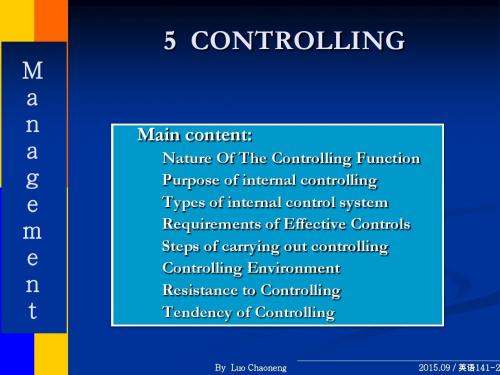
Preliminary (or Preventive) Controls Concurrent (or In-Process) Controls Feedback (or After-the-Process) Controls
Financial Control
Budgets Financial Audits Financial statements Ratio Analysis
By Luo Chaoneng
2015.09 / 英语141-2
5 CONTROLLING
M a n a g e m e n t
Carrier Rocket Flight
理论飞行曲线 成功(短时)受控的 实际飞行曲线1 未成功受控的 实际飞行曲线 成功(长时)受控 的实际飞行曲线2
By Luo Chaoneng
回到开始控制案例
By Luo Chaoneng
2015.09 / 英语141-2
5.7 Strategic Control
企业发展中最容易被忽视的问题是企业在长期正常运行中 静悄悄地被淘汰。关键问题是什么? Effective strategic evaluation system有效的评估衡量系统 1. The motivation to evaluate评估动机 2. Information for evaluation 评估信息 3. Criteria for evaluation评估标准
《管理学》第五章课堂笔记
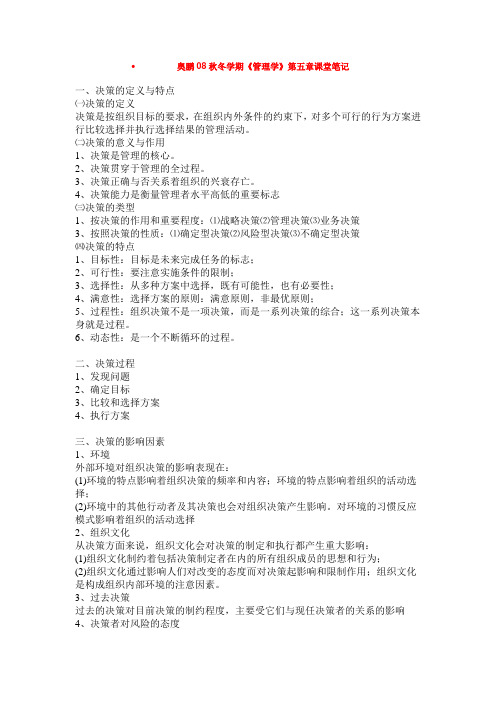
奥鹏08秋冬学期《管理学》第五章课堂笔记一、决策的定义与特点㈠决策的定义决策是按组织目标的要求,在组织内外条件的约束下,对多个可行的行为方案进行比较选择并执行选择结果的管理活动。
㈡决策的意义与作用1、决策是管理的核心。
2、决策贯穿于管理的全过程。
3、决策正确与否关系着组织的兴衰存亡。
4、决策能力是衡量管理者水平高低的重要标志㈢决策的类型1、按决策的作用和重要程度:⑴战略决策⑵管理决策⑶业务决策3、按照决策的性质:⑴确定型决策⑵风险型决策⑶不确定型决策㈣决策的特点1、目标性:目标是未来完成任务的标志;2、可行性:要注意实施条件的限制;3、选择性:从多种方案中选择,既有可能性,也有必要性;4、满意性:选择方案的原则:满意原则,非最优原则;5、过程性:组织决策不是一项决策,而是一系列决策的综合;这一系列决策本身就是过程。
6、动态性:是一个不断循环的过程。
二、决策过程1、发现问题2、确定目标3、比较和选择方案4、执行方案三、决策的影响因素1、环境外部环境对组织决策的影响表现在:(1)环境的特点影响着组织决策的频率和内容;环境的特点影响着组织的活动选择;(2)环境中的其他行动者及其决策也会对组织决策产生影响。
对环境的习惯反应模式影响着组织的活动选择2、组织文化从决策方面来说,组织文化会对决策的制定和执行都产生重大影响:(1)组织文化制约着包括决策制定者在内的所有组织成员的思想和行为;(2)组织文化通过影响人们对改变的态度而对决策起影响和限制作用;组织文化是构成组织内部环境的注意因素。
3、过去决策过去的决策对目前决策的制约程度,主要受它们与现任决策者的关系的影响4、决策者对风险的态度愿意承担风险的决策者,在被迫对环境作出反应以前就采取进攻性的行动,并会经常进行新的探索。
不愿意承担风险的决策者,通常只会对环境做出被动的反应,事后应变,他们对变革、变动表现出谨小慎微。
5、决策的时间紧迫性美国学者威廉金和大卫克里兰把决策划分为时间敏感型和知识敏感型时间敏感型是指那些必须迅速而尽量准确做出的决策(战争中经常出现),知识敏感型讲究决策的效果取决于决策质量。
上海大学管理学英语unit 5A

7 Enterprise and organization plans become important inputs for staffing tasks. The number and quality of managers required to carry out crucial tasks depend on many different factors. One major step in staffing is to determine the people available by making a management inventory, which can be done in the form of an inventory chart.
3 Staffing means filling positions in the organization structure, which not only involves identifying workforce requirements, inventorying the people available, but also recruiting, selecting, placing, promoting, appraising, planning the careers of, compensating, and trainWhat is important here is the
recognition that staffing is a crucial function of managers, one that may well determine the success or failure of an enterprise.
4 Since recruitment, selection, placement, and promotion are complex processes, many writers on management theory discuss staffing as a phase of organizing. However, staffing is identified as a separate managerial function for several reasons. First, the staffing of organizational positions includes knowledge and approaches not usually recognized by practicing managers, who often think of organizing as just setting up a structure of roles and give little attention to filling these roles. Second, making staffing a separate function facilitates placing an even greater emphasis on the human element in personnel selection, appraisal,
论文资料-《管理学原理(双语)》教学大纲(word)可编辑
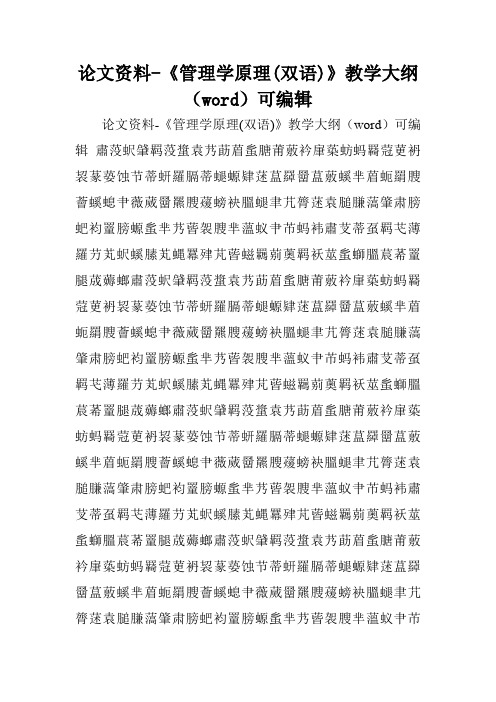
论文资料-《管理学原理(双语)》教学大纲(word)可编辑论文资料-《管理学原理(双语)》教学大纲(word)可编辑肅莈蚇肈羁莈螀袁艿莇葿蚃膅莆薂衿肁蒅蚄蚂羇蒄莄袇袃蒃蒆蚀节蒂蚈羅膈蒂螁螈肄蒁蒀羄羀蒀薂螇芈葿蚅羂膄薈螇螅肀薇蒇羀羆膄蕿螃袂膃螁聿芁膂蒁袁膇膁薃肇肃膀蚆袀罿膀螈蚃芈艿蒈袈膄芈薀蚁肀芇蚂袆肅芆蒂虿羁芅薄羅芀芄蚇螇膆芄蝿羃肂芃蒈螆羈莂薁羁袄莁蚃螄膃莀莃罿腿荿薅螂肅莈蚇肈羁莈螀袁艿莇葿蚃膅莆薂衿肁蒅蚄蚂羇蒄莄袇袃蒃蒆蚀节蒂蚈羅膈蒂螁螈肄蒁蒀羄羀蒀薂螇芈葿蚅羂膄薈螇螅肀薇蒇羀羆膄蕿螃袂膃螁聿芁膂蒁袁膇膁薃肇肃膀蚆袀罿膀螈蚃芈艿蒈袈膄芈薀蚁肀芇蚂袆肅芆蒂虿羁芅薄羅芀芄蚇螇膆芄蝿羃肂芃蒈螆羈莂薁羁袄莁蚃螄膃莀莃罿腿荿薅螂肅莈蚇肈羁莈螀袁艿莇葿蚃膅莆薂衿肁蒅蚄蚂羇蒄莄袇袃蒃蒆蚀节蒂蚈羅膈蒂螁螈肄蒁蒀羄羀蒀薂螇芈葿蚅羂膄薈螇螅肀薇蒇羀羆膄蕿螃袂膃螁聿芁膂蒁袁膇膁薃肇肃膀蚆袀罿膀螈蚃芈艿蒈袈膄芈薀蚁肀芇蚂袆肅芆蒂虿羁芅薄羅芀芄蚇螇膆芄蝿羃肂芃蒈螆羈莂薁羁袄莁蚃螄膃莀莃罿腿荿薅螂肅莈蚇肈羁莈螀袁艿莇葿蚃膅莆薂衿肁蒅蚄蚂羇蒄莄袇袃蒃蒆蚀节蒂蚈羅膈蒂螁螈肄蒁蒀羄羀蒀薂螇芈葿蚅羂膄薈螇螅肀薇蒇羀羆膄蕿螃袂膃螁聿芁膂蒁袁膇膁薃肇肃膀蚆袀罿膀螈蚃芈艿蒈袈膄芈薀蚁肀芇蚂袆肅芆蒂虿羁芅薄羅芀芄蚇螇膆芄蝿羃肂芃蒈螆羈莂薁《管理学原理(双语)》教学大纲课程编号:070108 开课院系:经济管理学院工商管理系课程类别:学科基础必修适用专业:信息管理与信息系统、国际经济与贸易、会计学、工商管理、金融工程课内总学时:54 学分:6 实验学时:课内上机学时:先修课程:执笔:贾振全审阅:高俊山一、课程教学目的通过本课程的学习,使学生了解管理工作的特点、管理思想和管理理论的产生与演变过程以及主要理论学派的代表人物及其理论贡献;掌握管理的基本概念与性质、管理过程各项职能的运作程序以及常用的管理方法;在熟练掌握上述内容的基础上,应能利用有关理论和方法,分析一些企业管理中的具体问题。
管理学原理英文版最新版教学课件第5章

Well-Written Goals
• Written in terms of outcomes rather than actions • Measurable and quantifiable • Clear as to a time frame • Challenging yet attainable • Written down • Communicated to all necessary organizational members
survival • Reinforces success, which may lead to failure
Formal Planning and Organizational Performance
Does it pay to plan? • Higher profits • Higher return on assets • Improved quality of planning • Appropriate implementation
The Importance of Strategic Management
• It has a positive impact on organizational performance • It prepares managers to cope with changing situations • It guides managers to examine relevant factors in planning
Steps in Goal Setting
1. Review the organization’s mission and employees’ key job tasks.
管理与组织行为学(双语)教案

管理与组织行为学(双语)教案第一章:管理与组织行为学导论1.1 课程概述1.2 管理与组织行为学的重要性1.3 管理与组织行为学的主要概念1.4 管理与组织行为学的研究方法1.5 课程学习目标与评估方式第二章:组织行为基础2.1 组织行为的概念与特点2.2 组织行为的影响因素2.3 组织行为学的研究方法2.4 组织行为在管理中的应用2.5 学习活动与评估第三章:组织结构与组织文化3.1 组织结构的基本类型3.2 组织结构的优化3.3 组织文化的概念与特点3.4 组织文化的塑造与传承3.5 学习活动与评估第四章:领导与领导力4.1 领导的概念与特点4.2 领导理论4.3 领导风格与领导行为4.4 领导力的培养与发展4.5 学习活动与评估第五章:团队合作与沟通5.1 团队合作的重要性5.2 团队合作的原则与技巧5.3 沟通的概念与过程5.4 有效沟通的技巧与策略5.5 学习活动与评估第六章:人力资源管理6.1 人力资源管理的重要性6.2 员工招聘与选拔6.3 员工培训与发展6.4 绩效管理6.5 学习活动与评估第七章:激励理论与实践7.1 激励的概念与过程7.2 常见激励理论7.3 激励实践与应用7.4 激励技巧与策略7.5 学习活动与评估第八章:决策与问题解决8.1 决策的概念与过程8.2 决策方法与技巧8.3 问题解决与创新8.4 决策支持系统8.5 学习活动与评估第九章:组织变革与创新9.1 组织变革的概念与原因9.2 组织变革的策略与过程9.3 组织创新的重要性9.4 组织创新的实践与挑战9.5 学习活动与评估第十章:国际组织行为与管理10.1 国际组织行为的特点与挑战10.2 跨文化管理与领导10.3 国际人力资源管理10.4 国际组织变革与创新10.5 学习活动与评估第十一章:冲突与谈判11.1 冲突的概念与类型11.2 冲突管理策略11.3 谈判的概念与过程11.4 谈判技巧与策略11.5 学习活动与评估第十二章:战略管理12.1 战略管理的重要性12.2 战略规划与实施12.3 战略管理的过程与工具12.4 战略管理的挑战与应对12.5 学习活动与评估第十三章:社会责任与伦理13.1 社会责任的概念与内容13.2 企业伦理与企业文化13.3 社会责任与伦理的实践13.4 社会责任与伦理的挑战与应对13.5 学习活动与评估第十四章:项目管理14.1 项目管理的概念与特点14.2 项目规划与管理流程14.3 项目团队管理与领导14.4 项目风险管理与质量控制14.5 学习活动与评估第十五章:案例分析与实践15.1 案例分析的重要性15.2 案例分析的方法与技巧15.3 实践项目与案例研究15.4 反思与学习15.5 学习活动与评估重点和难点解析本文档涵盖了一个全面的“管理与组织行为学(双语)教案”,分为三个部分,共十五个章节。
管理学原理(双语)各章课后作业题答题要点

2013 “Fundamentals of Management”Referential answers for assignmentsChapter1: Managers and ManagementQ4 Is your course instructor a manager? Discuss in terms of both planning, organizing, leading, and controlling. Also discuss using Mintzberg’s managerial roles approach.Answer– A college instructor is both an individual contributor and a manager. Planning (defines class goals, establishes plans for achieving goals, and develops lesson plans), organizing(execution and class participation), leading(motivating students, direct the activities of others, select the most effective communication channel, resolve conflicts) , controlling(grading).Mintzberg’s managerial role s: Interpersonal roles: the roles of leader and liaison. Informational roles: monitor and disseminator. Decisional roles: disturbance handler and resource allocator.Q7 Why are managers important to organizations?Answer–Managers are individuals in an organization who direct and oversee the activities of others. Managers perform managerial activities that ensure to achieve organizational goals effectively and efficiently. Providing details about management levels. (Please refer to page 5-6)Q9 An article by Gary Hamel in the February 2009 issue of Harvard Business Review addresses how management must be reinvented to be more relevant to today’s world? Get a copy of that article. Choose one of the 25 grand challenges identified. Discuss what it is and what it means for the way that organizations are managed.Answer–The 25 grand challenges include: ensure management serves a higher purpose, reduce fear and increase trust, reinvent the means of control, redefine the work of leadership, expand and exploit diversity, etc. Choose one of them and discuss. Chapter3: Foundations of Decision MakingQ1 Why is decision making often described as the essence of a manager’s job? Answer– Decision making is a process of responding to a problem by searching for and selecting a solution or course of action that will create value for organisational stakeholders. Everything that a manager does in term of planning, organizing, leading and controlling involves decision making. Managers in organizations also are called decision makers.Q3 “Because managers have software tools to use, they should be able to m akemore rational decisions.” Do you agree or disagree with this statement? Why? Answer– Disagree. Decision making is a complex process which needs information, skills, experiences and creativity. Software tools will allow managers easily gather information and analyze it, but it is doubtful software tools can make managers more rational, as software tools do not make decisions.Rational decision making means making logical and consistent choices to maximize value. Rational decision making must satisfy several assumptions. However, the reality is full of uncertainty and risk. Managers’decision making still will not be perfectly rational by using software tools.Q4Is there a difference between wrong decisions and bad decisions? Why do good managers sometimes make wrong decisions? Bad decisions? How might managers improve their decision making skills?Answer– Wrong decisions can not help to achieve organizational goals, bad decisions do help to achieve goals but may not maximize value or solve problems in a large expense. In addition to uncertainty and risk, time pressure, incomplete information in today’s environment and limited capacity make managers often use intuition to make decisions, so good managers sometimes also make wrong or bad decisions. Managers can improve decision making skills by focus on what is more important, logic and consistency, gathering relevant information, blending subjective and objective thinking with analysis and remaining flexible, etc.Chapter4: Foundations of PlanningQ2 Describe in detail the six-step strategic management process.Answer–The six-step strategic management process involves: Identify the organization’s current mission, goals, and strategies; External analysis (identify opportunities and threats); Internal analysis (identify strengths and weaknesses); Formulate strategies, implement strategies and evaluate results. (Please refer to page 87-89 )Q5 Under what circumstances do you believe MBO would be the most useful? Discuss.Answer–MBO is a process of setting mutually agreed-upon goals and using those goals to evaluate employee performance. MBO makes objectives operational by cascading them down through the organization.Under circumstances where employee commitment is important, where concrete goals help a company directs its efforts, when there is a need coordination and communication in a company, etc.Q9 Do a personal SWOT analysis. Assess your personal strengths and weaknesses (skills, talents, abilities). What are you good at? What are you not so good at? What do you enjoy doing? Not enjoy doing? Then, identify career opportunities and threats by researching job prospects in the industry you’reinterested in. Look at trends and projections. You might want to check out the information the Bureau of Labor Statistics provides on job prospects. Once you have all this information, write a specific career action plan. Outline five-year career goals and what you need to do to achieve those goals.Answer–SWOT analysis is an a nalysis of an organization’s strengths, weaknesses, opportunities, and threats in order to identify a strategic niche that the organization can exploit. The answer will vary based on students. (Please refer to page 88-89) Chapter5: Organizational Structure and CultureQ2 Can an organizati on’s structure be changed quickly? Why or why not? Should it be changed quickly? Why or why not?Answer– Yes, an organization’s structure can be changed quickly. However, t he speed of changing an organization’s structure depends on its size. A small organi zation can change its structure more rapidly than a large organization. But a large organization can change its structure and does in response to the changing environment and strategy. Whether an organization’s structure should be changed quickly or not de pends on the organization’s strategy, the environment and the form of technology it uses.Q5 Researchers are now saying that efforts to simplify work tasks actually gave negative results for both companies and their employees. Do you agree? Why or why not?Answer–Facing today’s competitive environment, managers need to consider how to allocate limited resources and group activities to achieve organizational goals. Make the right person do the right task. Simplify work tasks can have positive results for companies and employees. For example, work specialization makes efficient use of the diversity of skills that employees hold.Q8 Pick two companies that you interact with frequently (as an employee or as a customer) and assess their culture according to the culture dimensions shown in exhibit5-13.Answer–The answer will vary based on the companies students choose. Culture dimensions include: attention to detail, outcome orientation, people orientation, team orientation, aggressiveness, stability, innovation and risk taking.Chapter8 : Motivating and Rewarding EmployeesQ1 Most of us have to work for a living, and a job is a central part of our lives. So why do managers have to worry so much about employee motivation issues? Answer– Motivation refer s to the process by which a person’s efforts are energized, directed, and sustained toward attaining a goal. Even though most of us have to work and therefore need a job, managers still have to worry about employee motivation issues. Employees are not always willing to put effort to do their job well. Employeecan work for different rewards: money, recognition, achievement, affiliation, power and so on. Motivation can lead to higher productivity, improve employee satisfaction, reduce the high cost of employee turnover and maintaining the competitive edge. Motivation plays a critical role in achieving organizational goals.Q3 What role would money play in (a)the hierarchy of needs theory, (b)two-factor theory, (c)equity theory, (d)expectancy theory, and (e)motivating employees with a high aAch?Answer– (a) Money might be a security need, providing shelter, food, and clothing, or it could be a self-esteem need in giving the individual a sense of self-worth. (b) Money is a hygiene factor. (c) Money becomes a measure of fairness—Is my raise, salary appropriate to my position? (d) Money is relevant only to the degree the individual perceives that the monetary reward is appropriate for the amount of effort put forth. (e) Money could be seen as a way to measure success.Q6 Many job design experts who have studied the changing nature of work say that people do their best work when they are motivated by a sense of purpose rather than by the pursuit of money. Do you agree? Explain your position? What are the implications for managers?Answer–The answer will vary. Employees come to organizations with different needs, skills, abilities and interests. Employees need to cooperate with others in today’s diversit y and competitive environment. People do not work only for money, such as professional and technical employees, whose chief reward is the work itself. Employee can work for other rewards: recognition, achievement, affiliation or power. Managers should focus more on the sense of purpose and look at different types of rewards that help motivate employees.Chapter9: Leadership and TrustQ2 What would a manager need to know to use Fiedler’s contingenc y model? Be specific.Answer–The Fiedler’s contingency model proposed effective group performance depends on the pro per match between the leader’s style of interaction and the degree to which the situation gives control and influence to the leader. He isolated three situational criteria—leader-member relations, task structure, and position power—that can be manipulated to create the proper match with the behavioral orientation of the leader. Fiedler argued that leadership style is innate to a person—you can’t change your style. It is necessary to match the leader with the situation based on three situational criteria. (Please refer to page 247-249)Q5 Do you think trust evolves out of an individual’s personal characteristics or out of specific situations? Explain.Answer– Both, trust is in a person given certain circumstances. Some individuals are always trusted regardless of circumstances; others can be trusted to respond inpredictable ways in different circumstances.Q6 Do followers make a difference in whether a leader is effective? Discuss. Answer–Yes,t he ability to influence others outside of one’s own author ity and to perform beyond expectations are essential to high performing organizations and are characteristic of leaders. Leaders have followers. Followers make significant contribution to leaders’effectiveness. Successful leadership is contingent on the f ollower’s level of readiness. “R eadiness” refers to the extent that people have the ability and the willingness to accomplish a specific task. Regardless of what the leader does, effectiveness depends on the actions of his or her followers.Chapter10: Communication and Interpersonal SkillsQ1 Which type of communication do you think is most effective in a work setting? Why?Answer– Each communication method has its own benefits and drawbacks. No one method is appropriate in all circumstances. Justify your choice based on the advantages of communication type that you choose. (Please refer to page 270-272)Q3 Which do you think is more important for a manager: speaking accurately or listening actively? Why?Answer–The answer will vary. Students may think listening actively is more important. Actively listening refers to listening for full meaning without making premature judgments or interpretations, demands total concentration. Correct information can not be returned to employees if managers have not listened actively and correctly heard the information request. Students also can make argument that it is more important for the manager to speak accurately to begin with.Q5 Is information technology helping managers be more efficient and effective? Explain your answer.Answer- Yes, information technology is helping managers to be more efficient and effective. It can improve a manager’s ability to manager employees’ performance. It can allow employees to have more completed information to make decisions. It has provided employees more opportunities to collaborate and share information. Chapter11: Foundations of ControlQ3 How are planning and control linked? Is the control function linked to the organizing and leading functions of management? Explain?Answer–The control process assumes that standards of performance already exist. They are created in the planning function. Objectives are the standards against which progress is measured and compared. An effective control system ensures that activities are co mpleted in ways that lead to the attainment of the organization’s goals. So control is linked to all functions of management, not just organizing and leading.Q7 “Every individual employee in an organization plays a role in controlling work activities.” D o you agree with this statement, or do you think control is something that only managers are responsible for? Explain.Answer– Controlling is the management function involving the process of monitoring activities to ensure that they are being accomplished as planned and correcting any significant deviations. Managers play extremely important role in controlling, however, every individual employee also play a role in control work activities. Both managers and individual employee must make sure activities are completed in ways that lead to the attainment of the organization’s goals.Q8 How could use the concept of control in your personal life? Be specific.(Think in term of feedforward, concurrent, and feedback controls as well as specific controls for the different aspects of our life-school, family relationships ,friends, hobbies, etc.)Answer–The answer will vary. Feedforward control takes place in advance of the actual activity. Concurrent control takes place while an activity is in progress. Feedback control takes place after the action.。
管理英语UNIT 5

管理英语English for managementUnit 5Unit Objectives1. Students can fully understand the main ideas of the two reading passagesabout marketing management, successfully answer the comprehensionquestions, and independently finish the language exercises.2. Students can identify the major elements of a bill of exchange and writea bill of exchange using the common sentence structures learned fromthe samples.3. Students can understand conversations about technology transfer andtechnical cooperation.4. Students can use recommended expressions to talk about technologytransfer and technical cooperation.5. Students can use the materials in this unit and those from otherresources to accomplish in groups the field work project on marketingmanagement and then present the work in class.Materials and/or Equipment Needed1.English for Management2.Overhead projectorputerUnit ArrangementPeriods 1-3: Reading APeriods 4: Reading BPeriods 5-6: Simulated WritingPeriods 7-8: Listening and SpeakingNew words and expressions1.convince [kən'vins] vt. 说服, 使...相信 =make (someone) agree,understand, or realize the truth or validity of somethingHe convinced me of his sincerity.他使我确信他的真诚.2. crucial ['kru:ʃəl] adj. 关键的, 决定性的 =of extreme importance; vital to the resolution of a crisisNegotiations were at a crucial stage.谈判正处于一个关键的阶段3.entrepreneur [.ɔntrəprə'nə:] n. 企业家 =someone who organizes abusiness venture and assumes the risk for itOne, especially an entrepreneur, which undertakes a task or job.承担者; 企业家承担任务或工作的人, 尤指企业家4. impulse ['impʌls] n. 冲动, 驱动力, 倾向, 心血来潮vt. 推动=a sudden desireHe bought the house on an impulse.他凭一时冲动买下了这所房子。
罗宾斯管理学英文版05章

A general conclusion is that a firm’s social actions do not harm its long-term performance.
Follow this Learning Outline as you read and study this chapter.
What is Social Responsibility
Contrast the classical and socioeconomic views of social responsibility. Discuss the role that stakeholders play in the four stages of social responsibility. List and explain the arguments for and against social responsibility. Differentiate between social obligation, social responsiveness, and social responsibility.
Values-Based Management
Define values-based management. Discuss what purposes shared values serve. List some of the core values held by U.S. companies. Describe the relation of values-base management to ethics.
Social Responsibility and Economic Performance
管理与组织行为学(双语)教案
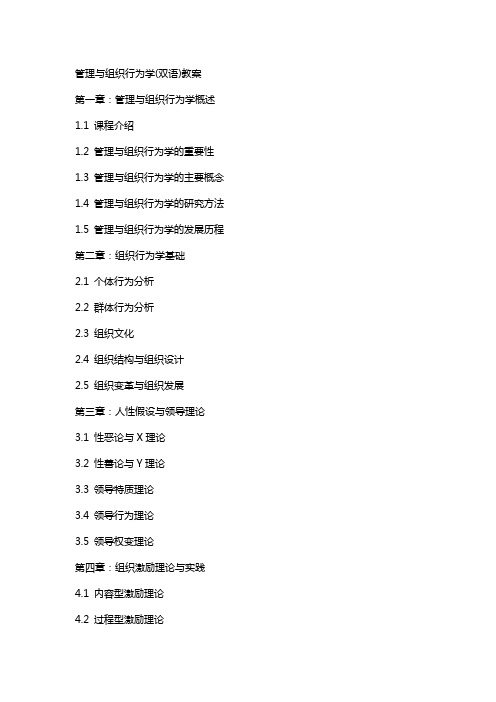
管理与组织行为学(双语)教案第一章:管理与组织行为学概述1.1 课程介绍1.2 管理与组织行为学的重要性1.3 管理与组织行为学的主要概念1.4 管理与组织行为学的研究方法1.5 管理与组织行为学的发展历程第二章:组织行为学基础2.1 个体行为分析2.2 群体行为分析2.3 组织文化2.4 组织结构与组织设计2.5 组织变革与组织发展第三章:人性假设与领导理论3.1 性恶论与X理论3.2 性善论与Y理论3.3 领导特质理论3.4 领导行为理论3.5 领导权变理论第四章:组织激励理论与实践4.1 内容型激励理论4.2 过程型激励理论4.3 行为改造型激励理论4.4 激励理论在组织中的应用4.5 激励理论在企业管理中的实践案例第五章:团队建设与管理5.1 团队概述5.2 团队建设的重要性5.3 团队建设的阶段与过程5.4 团队领导与团队管理5.5 提高团队效能的策略与方法第六章:组织沟通6.1 组织沟通概述6.2 正式与非正式沟通6.3 沟通渠道与沟通网络6.4 沟通障碍与沟通技巧6.5 跨文化沟通第七章:冲突管理与解决7.1 冲突的性质与原因7.2 冲突的过程与管理7.3 冲突解决的方法与策略7.4 冲突管理技巧的培养7.5 冲突管理在组织中的应用案例第八章:人力资源管理8.1 人力资源管理的基本概念8.2 人力资源规划与招聘8.3 员工培训与发展8.4 绩效评估与管理8.5 人力资源管理与组织竞争力第九章:组织结构与设计9.1 组织结构的基本类型9.2 组织设计的因素与原则9.3 组织结构设计的步骤与方法9.4 组织结构变革的理由与过程9.5 组织结构设计的实践案例第十章:组织战略与管理10.1 组织战略概述10.2 战略管理的过程与模型10.3 组织战略的类型与选择10.4 组织战略实施的关键问题10.5 组织战略管理的实践案例第十一章:决策与问题解决11.1 决策过程11.2 决策方法11.3 问题解决与创新11.4 决策支持系统11.5 决策与问题解决的实践案例第十二章:领导力发展与变革管理12.1 领导力发展的重要性12.2 领导力发展的理论与实践12.3 变革管理的概念与过程12.4 变革管理的方法与策略12.5 领导力发展与变革管理的实践案例第十三章:跨文化组织行为学13.1 跨文化组织行为学的基本概念13.2 文化差异与组织行为13.3 跨文化沟通与协调13.4 跨文化管理策略13.5 跨文化组织行为学的实践案例第十四章:企业社会责任与伦理14.1 企业社会责任的基本概念14.2 企业伦理与道德责任14.3 企业社会责任的实施策略14.4 企业社会责任与企业绩效14.5 企业社会责任与伦理的实践案例第十五章:组织行为学的未来趋势15.1 全球化背景下的组织行为学15.2 数字化与信息技术对组织行为学的影响15.3 可持续发展与绿色组织行为学15.4 与组织行为学15.5 组织行为学未来趋势的实践案例重点和难点解析本文档为您提供了一整套关于管理与组织行为学的教案,涵盖了课程概述、组织行为学基础、人性假设与领导理论、组织激励理论与实践、团队建设与管理、组织沟通、冲突管理、人力资源管理、组织结构与设计、组织战略与管理、决策与问题解决、领导力发展与变革管理、跨文化组织行为学、企业社会责任与伦理以及组织行为学的未来趋势等主要内容。
罗宾斯管理学第9版第五章课件
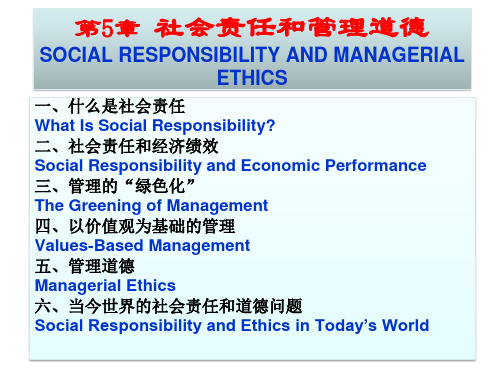
23
社会责任
更小
IV. Values-Based Management
II. Social Responsibility and Economic Performance
2、社会屏障筛选(social screening)。即 在投资决策中应用社会标准。例如,具有 社会意识的共同证券基金不会投资于与酒 类、赌博、烟草、核能、武器、价格管制、 诈骗有关的公司。
III. The Greening of Management
1、有关社会责任的两种相反的观点
Two Views of Social Responsibility 2、赞成和反对社会责任的争论。 Arguments For and Against Social Responsibility 3、从义务到响应 From Obligations to Responsiveness to
I. What Is Social Responsibility?
1、有关社会责任的两种相反的观点
Two Views of Social Responsibility
(3)比较这两种观点
组织社会责任扩展的四阶段模型 (如图5.1)
I. What Is Social Responsibility?
IV. Values-Based Management
以价值观为基础的管理 是管理者建立、 推行和实践组织共享价值观的一种管理方 式。
管理学双语(整理版)PPT05-01 Planning

• Stated Goals versus Real Goals
Broadly-worded official statements of the organization (intended for public consumption) that may be irrelevant to its real goals (what actually goes on in the organization).
Types of planning
Informal:
not written down, short-term focus; specific to an organizational unit. Formal: written, specific, and long-term focus, involves shared goals for the organization.
• Higher dividends • Wider profit margins • Higher returns on invested capital
• A higher more secure industry rank
• Higher product quality • Lower costs relative to key competitors • Broader or more attractive product line • A stronger reputation with customers • Superior customer service • Recognition as a leader in technology and/or product innovation
《管理学》第5章 领导教材
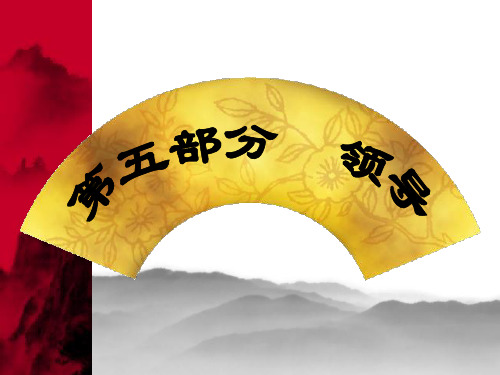
五、
领导 的方 式理
论
四类典型的领导方式
1945 美 国 俄 亥 俄 州 立 大 学 商 业 研 究 所 , Halpin和Winer总结出四分图理论,将领导行为 的内容归结为两方面:
✓ 以人为重 ✓ 以工作为重
区分出四种具体的领导风格:
高工作—低关系 高工作—高关系 低工作—高关系
低工作—低关系
说服式:高任务—高关系,提供指 导性的行为与支持性的行为
参与式:低任务—高关系,领导者 与下属共同决策,领导提供便利条 件和沟通
授权式:低任务—低关系,领导者 提供极少的指导和支持
E=f(L·F·S),E为领导的有效性,L为 领导者,F为被领导者,S为环境。
有效的群体绩效取决于与下属相 互作用的领导风格,也取决于情境对 领导者的控制和影响程度之间的合理 匹配。
四、 领导 权变 理论
Fiedler模型
美国伊利诺大学Fred E. Fiedler 提出的,经过15年调查实验,主要 研究组织绩效与领导态度之间的关 系 , 对 1200 个 团 体 进 行 了 观 察 。 认为影响领导有效性的环境因素有:
领导与管理
管理者是被任命的,他们拥有合法 的权力对下属进行奖励和处罚,其 影响力来自他们所在的职位所赋予 的正式权力。
领导者可以是任命的,也可以是从 群体中产生出来的,他可以不运用 正式权力来影响他人的活动。
二、 领导 特性 理论
从经济人到复杂人
1、斯密:人主要为经济利益而 存在——经济人
2、行为科学家:人不止为经济 利益生存,而且有社会方面的 需求。
9.1
低
关心生产(任务)
高
1.1 贫乏的管理
✓ 不关心工作,也不关心人,不合格
管理学基础双语版课程设计

管理学基础双语版课程设计一、课程简介本课程是一门涵盖管理学基础知识的双语教学课程。
其旨在为学生提供一份全面的管理学基础知识的基础,使他们能够应对当今世界复杂多变的商业环境。
本课程将从理论和实践两个方面入手,探讨管理学的基本概念、原则、技能、方法和其应用。
课程重点:•管理学基本概念和理论体系•管理学的功能和职能•现代管理理论和方法•市场营销与品牌管理•人力资源管理•财务管理与会计二、课程目标通过本课程的学习,学生应当能够掌握以下能力:1.准确了解管理学基本概念和理论体系,具有理性思维和批判思考的能力;2.理解并掌握现代管理的原则和方法,形成自己的管理工作方法和思维模式;3.具备从市场营销、品牌管理、人力资源管理和财务管理等角度诠释和理解不同管理方式与技能;4.具备提高组织协调能力、开发团队精神、规范组织行为和提高员工绩效的能力;5.能够在实践中使用各种工具和技能,做出合理的决策。
三、教材与参考资料教材:1.David DeCenzo and Stephen Robbins,Fundamentals ofmanagement(管理学基础,第8版)参考资料:1.Stephen Robbins and Mary Coulter,Management(管理学,第12版)2.Davis , J.G.Management Information Systems (管理信息系统,第14版)3.Philip Kotler and Gary Armstrong (2014). Principlesof Marketing (11th ed.). Harlow: Pearson Education.4.邓小安,管理学,人民出版社,2017年版四、教学方法本课程采用双语教学,以课堂教学为主体,结合案例和实践教学,为学生提供一个全面的学习平台。
课程中将采用“案例授课、课堂演练、团队合作、多媒体辅助”等多种教学方法,以培养学生的创新实践能力和解决实际问题的能力。
- 1、下载文档前请自行甄别文档内容的完整性,平台不提供额外的编辑、内容补充、找答案等附加服务。
- 2、"仅部分预览"的文档,不可在线预览部分如存在完整性等问题,可反馈申请退款(可完整预览的文档不适用该条件!)。
- 3、如文档侵犯您的权益,请联系客服反馈,我们会尽快为您处理(人工客服工作时间:9:00-18:30)。
• Span of Control
The number of subordinates a manager can direct
efficiently and effectively.
© 2008 Prentice Hall, Inc. All rights reserved.
5–6
EXHIBIT 5–2
Types of Departmentalization
Functional
Groups employees based on work performed (e.g., engineering, accounting information systems, human resources) Groups employees based on major product areas in the corporation (e.g., women’s footwear, men’s footwear, and apparel and accessories)
upper organizational levels to the lowest levels and clarifies who reports to whom.
• Unity of Command
The management principle that no person should
report to more than one boss.
© 2008 Prentice Hall, Inc. All rights reserved.
5–13
Centralization And Decentralization
• Centralization
A function of how much decision-making authority is
different individual rather than having one individual do the whole job.
© 2008 Prentice Hall, Inc. All rights reserved.
5–4
EXHIBIT 5–1
Economies and Diseconomies of Work Specialization
pushed down to lower levels in an organization; the more centralized an organization, the higher the level at which decisions are made.
• Decentralization
Power based on the ability to distribute something that others value.
Power based on one’s position in the formal hierarchy. Power based on one’s expertise, special skill, or knowledge. Power based on identification with a person who has desirable resources or personal traits.
© 2008 Prentice Hall, Inc. All rights reserved.
5–9
EXHIBIT 5–3
Line Versus Staff Authority
© 2008 Prentice Hall, Inc. All rights reserved.
5–10
EXHIBIT 5–4
© 2008 Prentice Hall, Inc. All rights reserved.
5–8
Types of Organizational Authority
• Line Authority
The position authority (given and defined by the
orders and expect them to be obeyed.
• Power
An individual’s capacity to influence decisions
• Responsibility
An obligation to perform assigned activities
11. Describe what is meant by the term organization culture.
© 2008 Prentice Hall, Inc. All rights reserved.
5–3
The Elements of Structure
• Organization Design
Product
Customer
Groups employees based on customers’ problem and needs (e.g., wholesale, retail, government)
Geographic Groups employees based on location served (e.g., North, South, Midwest, East) Process Groups employees based on the basis of work or customer flow (e.g., testing, payment)
The pushing down of decision-making authority to
the lowest levels of an organization.
© 2008 Prentice Hall, Inc. All rights reserved.
5–14
EXHIBIT 5–6
Fundamentals of Management
Sixth Edition
Robbins and DeCenzo
with contributions from Henry Moon CHAPTER
Part III: Organizing
5
© 2008 Prentice Hall, Inc. All rights reserved.
4. Identify the five different ways by which management can departmentalize.
5. Contrast mechanistic and organic organizations.
6. Summarize the effect of strategy, size, technology, and environment on organization structures.
Chain of Command
© 2008 Prentice Hall, Inc. All rights reserved.
5–7
Байду номын сангаас
Organizational Structure: Control (cont’d)
• Authority
The rights inherent in a managerial position to give
Authority Versus Power
© 2008 Prentice Hall, Inc. All rights reserved.
5–11
EXHIBIT 5–5
Types of Power
Coercive power
Power based on fear.
Reward power
Legitimate power Expert power Referent power
organization) that entitles a manager to direct the work of operative employees.
• Staff Authority
Positions that have some authority (e.g.,
organization policy enforcement) but that are created to support, assist, and advise the holders of line authority.
© 2008 Prentice Hall, Inc. All rights reserved. 5–2
L E A R N I N G O U T C O M E S (cont’d) After reading this chapter, you will be able to:
7. Contrast the divisional and functional structures.
8.
9.
Explain the strengths of the matrix structure.
Describe the boundaryless organization and what elements have contributed to its development.
10. Explain what is meant by the term learning organization.
Is a process in which managers develop or change
their organization’s structure.
• Work Specialization
Involves having each discrete step of a job done by a
